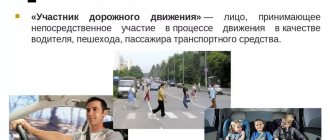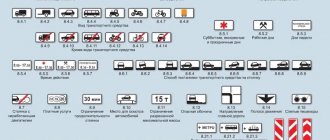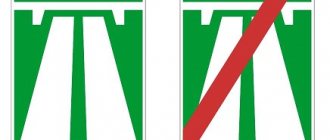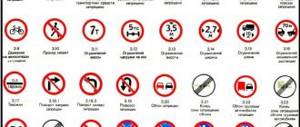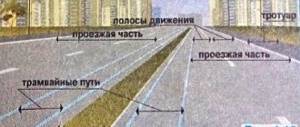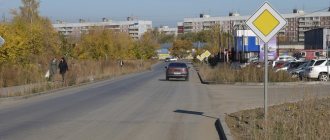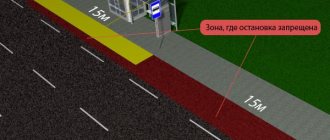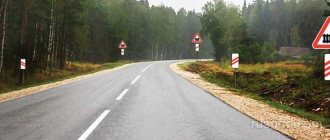Visual traffic control symbols may be installed for a limited period. They differ from stationary ones in appearance, but sometimes drivers confuse the temporary sign with the permanent one located on the yellow-green board. In addition, many are confident that they will not face anything for ignoring the requirements of the current limited-term symbol.
Read about what temporary road signs are, where and how they are installed, as well as the rules they dictate.
Temporary road signs in traffic regulations and their features
The traffic rules stipulate that the following symbols can be valid for a limited period:
- 1.8, notifying that traffic is regulated by a traffic light;
- 1.15, installed on slippery surfaces;
- 1.16, informing about uneven roads;
- 1.18, warning about the release of gravel under the wheels of the car;
- 1.20.1-1.20.3, installed before the narrowing of the web;
- 1.21, notifying about the establishment of two-way traffic;
- 1.25, informing about road works;
- 1.32, indicating that there is a traffic jam on the way;
- 1.33, warning of danger;
- 1.34.1, 1.34.2, indicating the direction of rotation;
- 2.5, prohibiting driving without stopping;
- 2.6, determining the advantage of oncoming traffic;
- 2.7, limiting the scope of the previous pointer;
- 3.20, prohibiting overtaking in the area;
- 3.21, terminating 3.20;
- 3.24, limiting the maximum permitted speed;
- 3.25, completing the zone of influence of the previous symbol;
- 4.2.1-4.2.3, indicating the need to go around an obstacle;
- 6.17, showing the detour scheme;
- 6.18.1-6.18.3, showing the direction in which to avoid the obstacle;
- 6.19.1, 6.19.2, establishing the need to change lanes to another carriageway when the first one is closed to traffic.
But taking into account specific conditions, any designation can be established for a limited period.
According to traffic regulations, temporary road signs are often combined with each other and supplemented with signs that clarify the territory of their influence or indicate the distance to the problem area. Some of them are rare. Others can be seen in populated areas as well as on highways.
We recommend reading about what traffic markings are like on the road. From the article you will learn about the types of markings according to traffic regulations, what markings mean depending on color and application, what to do if the markings are not visible on the road. And here is more information about how to follow the “Main Road” road sign.
When must temporary signs be removed?
The Code of Administrative Offenses and federal laws say nothing about how urgently invalid signs should be removed. Usually, to resolve such situations, they resort to GOST standards. Thus, GOST 33220-2015 specifies the requirements for the condition of highways.
More on the topic: What happens to driving without a driver's license?
Important! According to clause 4.4 of GOST 33220-2015, 1 day is allotted for dismantling temporary signs (after eliminating the reasons that led to their installation).
In addition to this document, the driver has the right to refer to standard R 50597-2017, which was introduced to replace the outdated GOST 50597-93. GOST R 50597-2017 describes the requirements for roads and streets.
Reference! Clause 6.1.2 states that temporary signs installed in connection with the repair of any roads must be dismantled within 24 hours after completion of the work for which they were installed.
This paragraph also states that after road maintenance work, temporary signs must be removed completely within 1 hour. In any case, if the repairs were completed more than a day ago, and the signs are still on the road, then the actions of the authorities and contractors are completely unlawful.
But GOST standards are not mandatory!
When arguing with traffic police inspectors and judges (if you decide to appeal the fine), the driver may hear that GOSTs are only recommendations and not strict regulations. In reality, this opinion is not substantiated by anything.
Important! Order of the Government of the Russian Federation No. 2438-r (as amended on October 29, 2018) establishes a wide list of various documents that are mandatory for use, since they directly control road safety.
This list mentions the same national standard GOST R 50597-2017, which requires signs to be removed within 24 hours after completion of repairs.
In addition, you can refer to the technical regulation of the Customs Union 014/2011, to which is attached the decision of the Board of the Eurasian Economic Commission No. 159. This decision provides a list of various standards, the requirements of which must be met on a voluntary basis in order to ensure traffic safety. The previously mentioned GOST 33220-2015 is on this list.
More on the topic: Types of car rentals. Rent with subsequent purchase
Finally, paragraph 7 of Article 11 of Federal Law No. 443 “On Traffic Management” directly states that the placement of additional traffic management equipment (not specified in the documentation) is not allowed. Thus, if temporary signs are not reflected in the contractor’s documents, then their use becomes illegal.
What to do with all these regulations? The driver must know that he has the right to go to court if he receives a fine or an administrative decision, the reason for which was a sign that was not removed on time. To confirm your rights, you must refer to the following documents:
- Code of Administrative Offenses of the Russian Federation;
- Federal Law No. 196 “On Road Safety”;
- Order of the Government of the Russian Federation No. 2438-r;
- Technical Regulations of the Customs Union 014/2011;
- Federal Law No. 443 “On the Organization of Road Traffic”.
Reference! In some cases, the court requires documentation from the contractors who carried out the repair work. The submitted documents must indicate the dates of work carried out in the disputed area.
If an offense (speeding) was recorded before one day had passed since the completion of the repairs, then the court may not grant your request. The fact is that the law allows dismantling to be carried out within 24 hours, so claims against the contractor are unlawful.
If the repair work has long been completed, and contractors and road services are in no hurry to remove temporary signs, then the court will definitely rule in your favor. The persons mentioned are directly responsible for the condition of the road and the organization of traffic, so they may be punished. In this case, the driver’s fine (or other order) is automatically removed.
Speed limits
Temporary "Speed Limit" road signs are usually used where repairs are underway, a detour is required, or you have to drive along a narrow section. And driving fast can lead to an accident.
3.24 yellow is often combined with the symbols 3.20, 4.2.1-4.2.3, 1.15,1.16, 1.18 or 1.20.1-1.20.3. Sometimes several speed limit indicators are placed one after another so that cars reduce it smoothly. For example, on the first segment it should be no more than 70 km/h, on the next – up to 50 km/h, on the final – up to 40 km/h.
And next to 3.24 there may be a sign 8.2.1. It shows the length of the section along which you should drive at a limited speed. If it is not there, you should look for symbol 3.25, which completes the area of influence of 3.24.
During road works
It is temporary signs during road works that can be found most often. They are almost never permanent, that is, with a white background.
1.25 requires special attention from drivers. In its coverage area there is not only a problem road, but also special equipment, materials and workers. Here it is necessary to reduce the speed, so symbol 3.24 is installed nearby. Crushed stone may fly from the road under the wheels, which will be warned by designation 1.18. And the width of the area left for travel is reduced, so from 1.25 signs 1.20.1-1.20.3 are fixed.
If the section under repair needs to be bypassed, drivers will see symbols 6.17 or 6.18.1-6.18.3. Additional signs (but not plates) must also be yellow.
1.25 has installation features:
Sign 1.25 when carrying out short-term work on the roadway can be installed without sign 8.1.1 at a distance of 10 - 15 m from the work site.
And outside the city or village it is repeated 50 m before the dangerous segment. In populated areas, 1.25 is placed directly in front of the area being repaired.
Possible changes
Quite often, conflict situations between drivers and State Traffic Inspectorate employees arise due to temporary signs that were not removed on time or forgotten by workers during repairs. The argument “this has never happened here before” has little effect on traffic police officers; in such a situation, the driver is most likely found guilty.
Therefore, in order not to get caught yourself and to protect your colleagues from troubles, if you find a temporary sign forgotten on the road, report the fact to the State Traffic Inspectorate or call the hotline of the Ministry of Internal Affairs.
What changes regarding road signs can vehicle owners expect in the near future?
The capital's Center for Optimizing Transport Traffic proposed improving the category of temporary signs by adding bright yellow or light green paint to the components.
According to the creators of the project, new color solutions will improve the concentration of drivers and make the signs more visible to road workers.
The authors of the idea propose installing signs not only in places of road work, but also when there are changes in traffic flow or speed limits.
A bright sign will be quickly remembered by drivers, after which it can be changed to a permanent one.
The proposal has been accepted for consideration, but the idea is far from being legally formalized, since such innovations require amendments to many legislative documents, acts and approval by the State Duma.
Portable and yellow
Yellow temporary road signs are often confused with permanent ones located on a rectangular base of the same color. But in the second case, this background is external. Inside, the permanent symbol is white and the main image is drawn on it. And the yellow-green surroundings make it easier to see in the dark.
The temporary indicator has a yellow background inside the border. It contains the main image. Simultaneously with the installation of non-permanent signs, permanent signs must be removed or hidden. But they often remain visible.
A characteristic feature of symbols used for a limited period is the installation method. They can be placed directly on the roadway in the form of a “clamshell”. Portable temporary road signs are easier and faster to install and remove. In addition, several signs can be placed on one folding support at once. The method is legalized by GOST:
In places where work is being carried out on the road and during temporary operational changes in the organization of traffic, signs on portable supports may be installed on the roadway, roadsides and dividing strip.
Is the person who did not remove the signs after repairs violate?
Now we need to figure out whether the actions of the authorities and the contractor who carried out the repairs are legal. It is due to their oversight that temporary signs remain on the road, causing so many problems for drivers.
Article 21 of Federal Law No. 196 “On Road Safety” establishes that all road activities are carried out for the following purposes:
- ensuring road safety;
- increasing road capacity.
Returning to our signs, we will find that forgotten temporary signs have nothing to do with the safety of the road situation. At the same time, they force drivers to slow down, which directly affects the capacity of a particular road.
Reference! The temporary signs left are contrary to the requirements of Russian legislation, and therefore the actions of the authorities, contractors and traffic police inspectors themselves can be regarded as negligence.
Validity area of temporary signs
Yellow traffic control symbols are not only limited in terms of their use. The coverage area of temporary road signs is also not endless. It may be limited to:
- Another symbol signifying the end of the territory of influence of the previous one. For example, for a section with a speed limit it is 3.25. The second pointer should also be yellow.
- Table 8.2.1. It shows at what distance the sign attached next to it is valid and is installed with a repeat symbol.
- Tables 8.2.2, 8.2.3. Used less frequently.
- Index 3.31. It means the completion of all restrictions imposed up to this point.
If there are no listed symbols (which is rare), the territory of influence ends at the intersection closest to the installation site or at the beginning (end) of a populated area.
Temporary signs and symbols on a yellow-green background
Vehicle owners know that road signs differ in image, background, and details that have a specific meaning.
Fixed road symbols are painted on a white background, and temporary road signs are painted on a yellow background .
A characteristic feature of transit components is the installation of equipment that regulates traffic for a certain period of time, after which the signs are covered or dismantled. Similar elements include temporary road markings that are orange in color.
The function of temporary signs is to warn about repair work or emergency situations ongoing on a section of the highway. If the indications of permanent and temporary symbols conflict with each other, traffic rules recommend following the temporary designations.
In order not to provoke contradictions between temporary and permanent traffic signs, the rules provide for the covering of permanent signs during road repairs with special covers or dismantling of equipment.
GOST rules regulate the process of installing temporary signs that are removed upon completion of repair work.
Order of the Ministry of Internal Affairs of the Russian Federation No. 664 (08/23/2017) canceled the previous ban on the use of automatic traffic detection devices at the locations of temporary signs.
Even experienced drivers make the mistake of mistaking signs on a yellow-green background for temporary warning signs. In fact, according to GOST, the purpose of the yellow-green background is to prevent road accidents, since the combination of bright colors, with the simultaneous use of reflective fluorescent film, is clearly visible and improves the concentration of drivers.
Such traffic control components remain visible at any time of the day and in any weather, so signs are placed:
- at pedestrian crossings;
- near social facilities: schools, hospitals, kindergartens, etc.
Preventive signs on a yellow-green background include signs 1.22, 1.23, 5.19.1, 5.192. Traffic regulations also allow the use of other road symbols in dangerous places and areas of heavy traffic (congestion) of vehicles.
Installation according to GOST
GOST R 52289-2004 requires temporary road signs to be mounted in a special way. In case of poor visibility, they are duplicated on the left side of the track, the dividing strip. Restricted symbols are located at a distance of at least 50 m from each other if we are talking about a section outside a city or village. And in populated areas it should be 25 m.
There are special installation requirements for some signs:
Outside populated areas, signs 1.1, 1.2, 1.9, 1.10, 1.23 and 1.25 are repeated. The second sign is installed at a distance of at least 50 m before the start of the dangerous section. Signs 1.23 and 1.25 are also repeated in populated areas immediately at the beginning of the dangerous section.
There is also this condition:
Signs are installed immediately in front of an intersection, a turnaround point, a service facility, etc., and if necessary, at a distance of no more than 25 m in populated areas and 50 m outside populated areas in front of them, except in cases specified by this standard.
Expert opinion
Nadezhda Smirnova
Automotive Law Expert
That is, some non-permanent symbols are installed directly in front of a difficult section where you need to change the driving mode, while others are also installed several tens of meters before it.
Functions of signs in the surrounding area
Adjacent territory is an area near the road that is not suitable for through vehicle traffic:
- residential courtyards,
- gas stations,
- industrial zone, etc.
Traffic in the surrounding area is regulated by current traffic regulations.
Road is a territory equipped for vehicle traffic and including the presence of: special coverage, road signs, markings, control devices and special services. The road includes one or more lanes, tram tracks, sidewalks, etc.
Disputes regarding the need to install signs in the surrounding area have been going on for a long time. Arguments of opponents of the idea: the adjacent area, according to current legislation, by definition, is not a road, and equipping the area with control signs is illegal.
At the same time, the passages and entrances of the adjacent territory, by law, belong to the roadway and fall under the definition of regulatory documents that classify the road as an area for traffic.
GOST R 52289-2004 indicates that traffic management components: signs, markings, light signaling, are used in the adjacent territory based on the principle of expediency of placement.
Traffic in the adjacent territory is regulated by current traffic regulations.
Bottom line: the rules for installing signs on the territory adjacent to the roadway are regulated by: regulations of the federal government and local governments, orders of the Ministry of Internal Affairs.
The presence of road signs on the ground indicates the presence of certain circumstances and specific traffic conditions that require knowledge and compliance with traffic rules.
Travel fine
The fine for temporary road signs, or rather driving under them not according to the rules, can be at least 500 rubles. There is part 1 of article 12.16 of the Administrative Code. But if the driver turned left or turned around the wrong way, stopped or parked, he will give 1000-1500 rubles.
We recommend reading about what road safety means. From the article you will learn about the road safety management organization responsible for its implementation. Here's more about the main warning signs.
Temporary road signs are a common cause of penalties. Because of them, it is difficult to change the usual driving habits on a well-known section of the road. And yet you will have to do this, because now you can be fined for a violation even if it is recorded by a video camera.
Legality of fines for failure to remove temporary signs
Reference! Article 12.9 of the Code of Administrative Offenses of the Russian Federation establishes sanctions for speeding (administrative fines or deprivation of a driver’s license).
When imposing a fine, traffic police officers refer specifically to this article, however, in the case of temporary signs that have not been removed, it is necessary to carefully understand the specific offense. According to the Administrative Code, any offense is considered from the point of view of established regulations. If the order is incorrect or subject to cancellation, then the misdemeanor cannot be considered an offense. In our case, the temporary sign loses its purpose after the repair is completed, and therefore cannot serve as a basis for imposing a fine.
Important! Article 24.5 of the Code of Administrative Offenses directly states the circumstances according to which no one has the right to make any decisions on a specific offense.
Thus, the consideration of administrative offenses must be terminated in the following cases:
- if there is no event of an offense;
- if there is no corpus delicti.
When translated from legal language into Russian, it turns out that the event of the offense is still present: the driver drove at a speed that is prohibited by a temporary sign. To determine whether an offense is present, its components should be determined:
- Object – certain relations or phenomena that are regulated and protected by regulations (including the Code of Administrative Offenses). In our situation, the object is understood as road safety.
- The objective side is the signs according to which it is possible to establish the fact of an offense, identify the result of the offense, the cause-and-effect relationship, motives and other circumstances.
- Subject – the person committing the offense (driver).
- The subjective side is the degree of guilt of the driver (the offense can be committed intentionally or through negligence).
More on the topic: Should a pedestrian? What should a pedestrian really do?
If you study all these 4 components of the offense, you will find that the object of the offense does not exist. Temporary signs are installed in connection with repairs, as the condition of the roadway is deteriorating, and this entails an increased risk of accidents. After the repair, the danger of losing control disappears, and the left sign does not affect the road situation at all.
Attention! If the road repair is completed, then the object of the offense disappears, thus, if the specified speed is exceeded, the driver does not commit any offenses.
When considering a specific case, traffic police officers are required to prove all the components of the offense (except for the subject, since he initially appears in the case as a violator). The resolution usually indicates the phrase “Found guilty,” which is a sign of the subjective side. The object and objective side of the offense do not exist in this case, therefore the driver cannot be held accountable.
